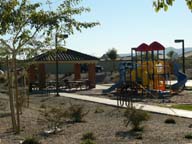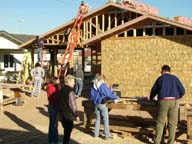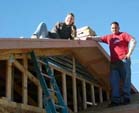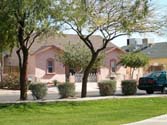One Family at a TimeThe Valley has a reputation of being one of the more affordable metropolitan areas in the West. However, according to the article “Affordable Housing Scarce” by Catherine Reagor and Bill Hart that was printed in the Arizona Republic in April of 2002, this past decade has seen housing prices rise twice as fast as income. Now due to a shortage of affordable housing (federally defined as housing that costs no more than 28 percent of a household’s monthly income), more than 1 in 10 Arizonan households are condemned to overcrowded or substandard living conditions. There are many barriers to affordable housing, including limited and expensive land, low wages, lack of jobs, zoning, lack of infrastructure, and governmental fees. Despite the neighborhood opposition to bringing in affordable housing, Habitat for Humanity is working to confront this problem in South Phoenix. Beginning in 1995, Habitat built South Ranch, a planned development consisting of 195 homes, a children’s playground, a community center, and a homeowners association. This was the first complete neighborhood of Habitat homes ever built. As I viewed the neighborhood nearly a decade later, I was impressed by the well-kept homes, beautiful architecture, and clean street. This may be due to the strict criteria that Habitat uses to select homeowners. Applicants must have a need for adequate housing, have a two-year history of stable income, and be willing to partner with Habitat. These people actually build their own home along with volunteers. They are not just given a home; they must invest their time, sweat, and energy into it. As a result it truly becomes theirs, as evidenced by the beautiful neighborhood of South Ranch. Due to the success of this development, Habitat decided to do it again a couple of miles down the street. Villas Esperanza began construction in the fall of 2002. This Habitat development will cover 20 acres and will also include a children’s playground, a community center, and a homeowners association. It is here that I had the privilege of helping to construct one of the homes. Along with my classmates, I worked my way around the roof measuring and nailing in the trimming. By the end of the morning, we had completed this small piece of the house. We walked away with the satisfaction of knowing that we had contributed to the livelihood of the family who would one day live there. We were only a few of the thousands of volunteers who dedicate time, energy, and sweat to this work. These people, along with financial supporters and Habitat staff, truly make a difference in the South Phoenix community—one family at a time. Why then has Habitat faced opposition as they constructed these communities? There are a variety of reasons. However, one may be that people are experiencing illegitimate fear. The concept of affordable housing brings to their minds a picture of poor people living in slums and all the problems that ensue. Therefore, they fear for their security. However, in the article “Architecture of Fear,” Edward Blakely and Mary Snyder discuss how modern landscape (including home design, gated communities, zoning regulations, and semi-public space) is shaped by fear. They concluded that the “social structure of a community is more important than its physical features in combating crime and maintaining quality of life.” In light of this knowledge, the fear of Habitat’s opponents is illegitimate because of the social structure that exists within Habitat communities. The security of the neighborhood is maintained by the strong ties that people have to their homes rather than by the type of housing that is present. Click here to view a video of our class working on the house. |
||
 |
||
 |
||
| Return to My Home Page | Contact: rachel.gregoire@asu.edu | |


